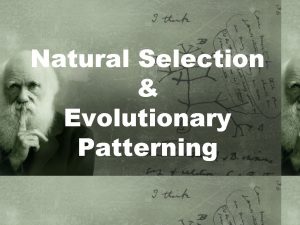Natural selection and isolation Natural Selection There are





- Slides: 5

Natural selection and isolation

Natural Selection There are variations within every population of species n Organisms that don’t reproduce have their genes removed from the population n Organisms that survive and reproduce are well suited to their environments n Favourable variations are passed onto offspring and become common n

Isolation ¨ The Role of Isolation: n For a new species to evolve, groups of organisms need to become isolated from each other n Usually the organisms become separated by a physical barrier n Within each separate population, different mutations occur, and therefore, different variations are produced n Natural selection acts differently on each isolated population, as there are different environmental conditions and selection pressures n Over time the populations differ so much that they no longer interbreed, and as such, a new species was produced n Isolation can be created by a difference in food preference, to the splitting of the continents.

Divergent Evolution n n n Also known as adaptive radiation It is the process whereby one species radiates out into different environments and as a result produces organisms that look different from each other, and may have many other differences. One of the best known examples are Darwin’s finches 14 different species where described; all with similar greyish-brown to black feathers and all had similar calls, nests eggs and courtship displays However, their habitats, diets, body size and beak sizes differed throughout Darwin believed that they had all evolved from a common ancestor

Convergent evolution Natural selection over many generations can result in similar adaptations in species that live in similar environments, even though they may be unrelated n This is called evolutionary convergence n For example, the seal and the dolphin both live in the ocean n They have flippers as limbs, they are strong swimmers, can hold their breath longer than most mammals, and they have a layer of fat under their skin. n But they belong to different orders of mammals and are unrelated. n









